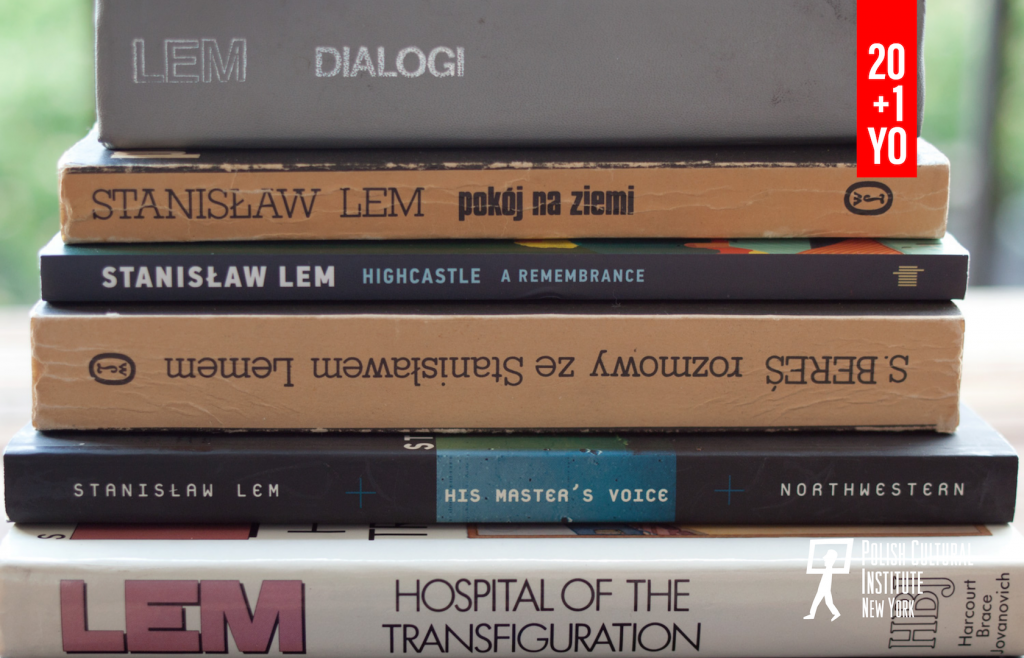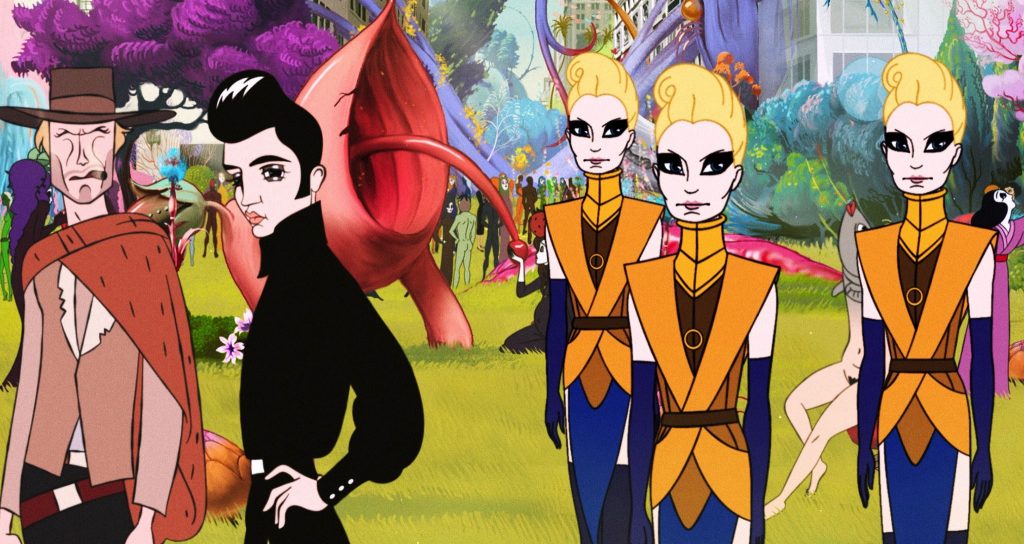Stanisław Lem’s Centennial
Stanisław Lem (1921-2006) was a visionary Polish science fiction writer. He also wrote various essays on the themes of philosophy, futurology, and literary criticism. Lem’s books have been translated into over 50 languages and have sold in over 45 million copies. He is best known as the author of the 1961 novel Solaris, which has been made into a feature film three times.
Today (September 13, 2021), worldwide, we celebrate Lem’s centennial. The Polish Cultural Institute New York has prepared for you an insight into Lem’s oeuvre in four parts: Lem in Space, Lem in Library, Lem in Film, and Lem in Music.
Lem in Space
Did you know that Lem and his characters or novels exist in outer space? On June 10, 2009, a distant planet was found in the constellation of Pegasus, approximately 161 light years away of Earth, by prof. Andrzej Niedzielski and his team from the Nicolaus Copernicus University in Toruń. It was named Pirx, after one of Lem’s characters. Planet Pirx orbits around a star called Solaris. The two names are absolutely official. They were granted by International Astronomical Union in a global competition for the names for newly discovered planets outside our solar system. It is worth mentioning that in prof. Niedzielski’s team worked prof. Aleksander Wolszczan, the first astronomer in the world who proved existence of planets deep in space. For his observations in 1991 he used famous Arecibo telescope in Puerto Rico.
You can also find Lem himself, or rather his name, among celestial bodies. In 1992 the International Astronomical Union named Lem a planetoid belonging to the main asteroid belt in our solar system. The asteroid which previously was named with a number only (No. 3836) was discovered in September 1979. It orbits the Sun in 3 years and 128 days at an average distance of 336 million kilometers. The circumsolar orbit of the planetoid Lem lies between the orbits of Mars and Jupiter. Anybody interested in details can follow the orbit of Lem on the NASA website.
There is one more planetoid in our solar system named after Lem’s characters. It is Ijontichy (planetoid no 343000) discovered on January 29, 2009 by Erwin Schwab and Ute Zimmer and named after the character form “The Star Diaries.” Check out the orbit Ijontichy here.
Lem in Library

Theodore Solotaroff of The New York Times Book Review wrote, “Lem is both a polymath and a virtuoso storyteller and stylist. Put them together and they add up to a genius… He has been steadily producing fiction that follows the arcs and depths of his learning and a bewildering labyrinth of moods and attitudes. Like his protagonists, loners virtually to a man, his fiction seems at a distance from the daily cares and passions, and conveys the sense of a mind hovering above the boundaries of the human condition: now mordant, now droll, now arcane, now folksy, now skeptical, now haunted and always paradoxical.”
A series of new translations of Stanislaw Lem books in English by Peter Butko (Dialogues), Antonia Lloyd-Jones (The Truth and Other Stories), Michael Kandel (His Master’s Voice; Highcastle: A Remeberance), Bill Johnston (The Invincible), Barbara Marszal and Frank Simpson (Return from the Stars), William Brand (Hospital of the Transfiguration), Joel Stern, Maria Swiecicka-Ziemianek and Antonia Lloyd-Jones (Memoirs of Space Traveler) is available at MIT Press.
Lem’s accomplishments in literature are further explored by the Polish Cultural Institute New York in the eight episode of Encounters with Polish Literature, where we consider three works, Lem’s memoir of childhood, Highcastle, his early novel about the fate of a psychiatric hospital during Second World War, Hospital of the Transfiguration, and his science fiction masterpiece, Solaris, which would become the subject of films by Andrei Tarkovsky and Stephen Soderburgh.
Lem in Film

Lem’s novels and stories have inspired (and continue to inspire) numerous filmmakers, with cinematic adaptations emerging from throughout the world, often helmed by some of the most important filmmakers past and present: from Andrei Tarkovsky and Andrzej Wajda to the Quay Brothers and Steven Soderbergh. There is over 50 film and TV adaptations of Lem’s works created so far since 1957.
While Russian filmmaker Andrei Tarkovsky’s luminous Solaris (1972) stands as the best known film version of the Polish writers work, Lem, over the course of his nearly 60-year career and beyond, has also served as a source of inspiration for short and long works on both the television and cinema screens on multiple occasions, from the 1959 East European adaption of his debut novel Astronauts (1951) as The Silent Star (AKA First Spaceship on Venus) to Israeli director Ari Folman’s recent, partially animated reimagining of The Futurological Congress (1971) as The Congress (2013).
On September 12, 2021 we began a film series, organized by MUBI in collaboration with the Polish Cultural Institute New York, offering a selection of Lem-inspired cinematic works. Employing diverse stylistic techniques such as animation, puppeteering, and live-action, the films are as varied in style as the author’s works, encompassing the spirit of one of SF literature’s greatest, boundary-breaking bodies of work. The selection includes Ari Folman (The Congress), György Pálfi (His Master’s Voice), Andrzej Wajda (Roly Poly), Marek Piestrak (Pilot Pirx’s Inquest), Edward Zebrowski (Hospital of the Transfiguration) and Stephen Quay & Timothy Quay (Maska). MUBI is a global streaming service available across 190 countries, with more than 10 million members around the world.
Lem in Music
In the year dedicated to the extraordinary writer, we recommend complementing the literary, film, scientific, and philosophical events with an event for music aficionados. Works inspired by literature will be presented at this year’s Warsaw Autumn Festival. In the compositions of Aleksander Nowak and Mikołaj Laskowski, “real time intertwines with literary time and the writings of Stanisław Lem.” Aleksander Nowak lo firgai (The Mask) and Mikołaj Laskowski Fiasco will have their first Polish performances on Sunday, September 19th at 1:30pm EST/7:30pm CET. Performed by Austrian Ensemble Klangforum Wien and soprano Agata Zubel. Live streaming will be available on the Warsaw Autumn festival website.
Aleksander Nowak’s monodrama Lo firgai. The Mask for soprano and ensemble tackles the eponymous short story devoted to the imperfection of creation, transgression, and dualism. The work is sung in Lojban – an artificial language invented in the second half of the twentieth century to enable communication between people and machines.
The work by Mikolaj Laskowski Fiasco for ensemble and electronics, in opposition to Stanisław Lem’s Fiasco, humankind is contacted by non-human intelligence and the aliens attempt to recreate earth’s music.
The works were commissioned by Adam Mickiewicz Institute within the framework of “Lem and Thinking About the Future” program. The work lo firgai (The Mask) by Aleksander Nowak is from the PWM Edition catalogue.
More on Lem
Stanisław Lem (1921-2006), born in Lwów (today L’viv, Ukraine), is one of Poland’s most popular writers, known primarily for his widely translated science fiction works such as Solaris, The Cyberiad, and Pilot Pirx’s Inquest, though he expressed a certain ambivalence about the genre in his later interviews. One of Lem’s particular talents is the invention of fictional literatures, such as the entire history of the fictional science of “Solaristics” in the novel, Solaris, but he pursues this genre of fictional fictions for its own sake apart from science fiction, authoring introductions to and reviews of nonexistent books in Memoirs Found in a Bathtub and A Perfect Vacuum. While his science fiction works may be viewed as philosophical novels, he also wrote non-fiction works of philosophy and futurology including his Dialogues, Summa Technologiae, and many essays and extended interviews.
He grew up as an only child, the son of a successful laryngologist among Lwów’s urban secularized Jewish intelligentsia in the wake of the First World War, so he had the opportunity to mature into early adulthood in a comfortable, stable environment in independent Poland before the outbreak of World War II and relocation to Kraków after the war. He studied medicine at his father’s urging, but did not pursue a career as a physician. He began writing and publishing as early as 1946, but grew substantially in productivity and popularity after the Thaw of 1956, three years after the death of Stalin.
Please visit Culture.pl for detailed Lem’s biography as a writer, and a handful of articles and anecdotes on Lem as a man and a philosopher.
Lead image: Artistic vision of planet Pirx (c) Polskie Towarzystwo Astronomiczne.



